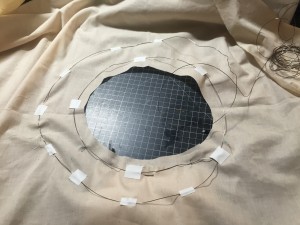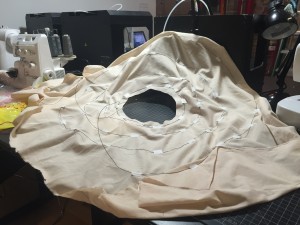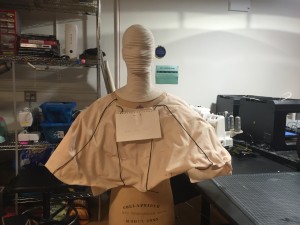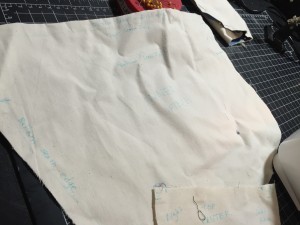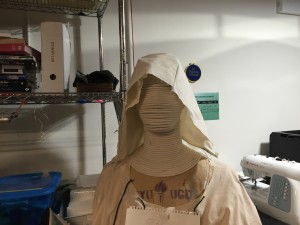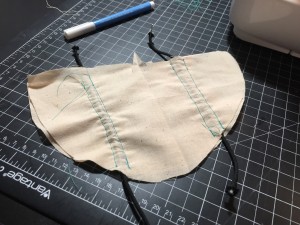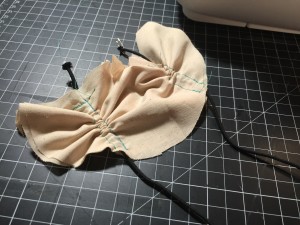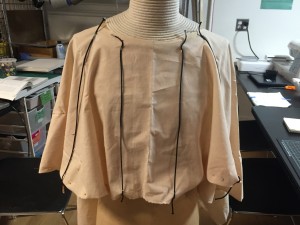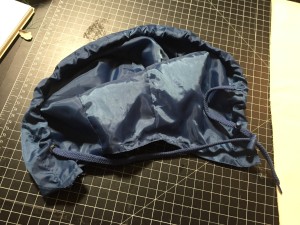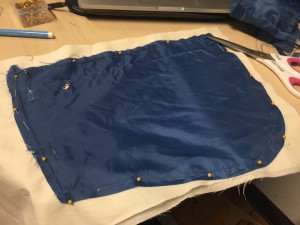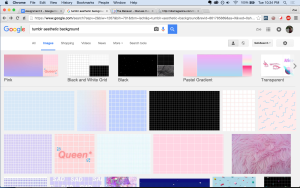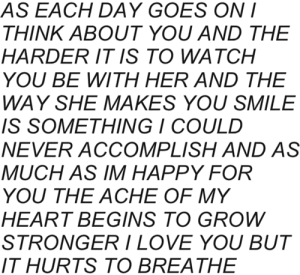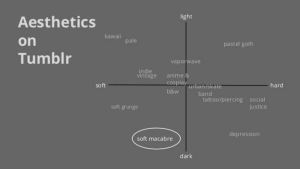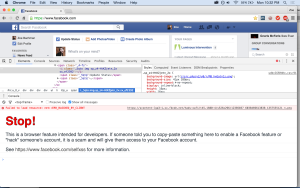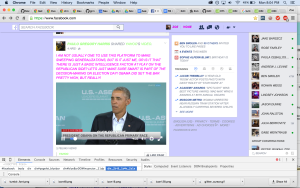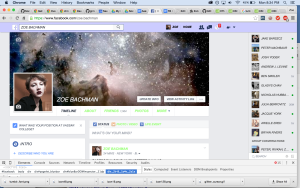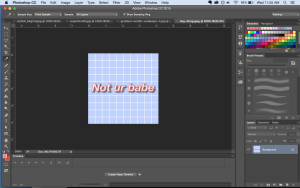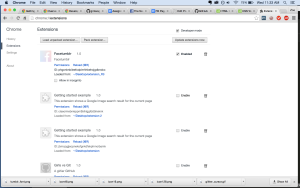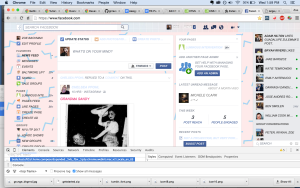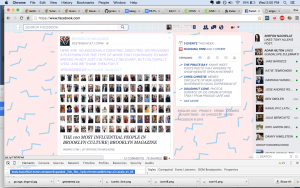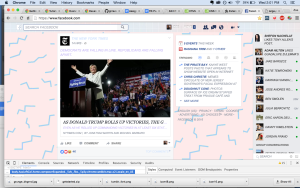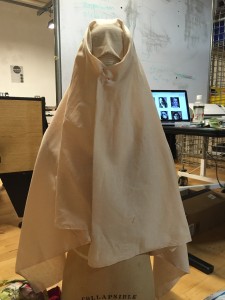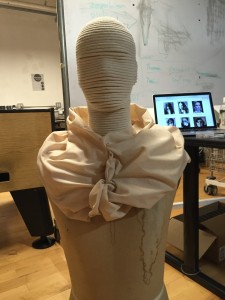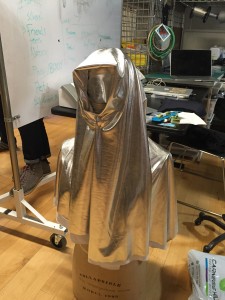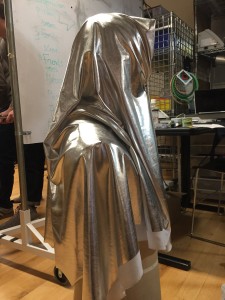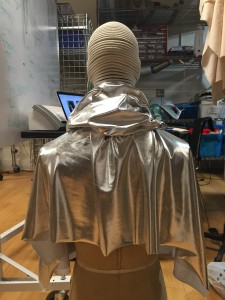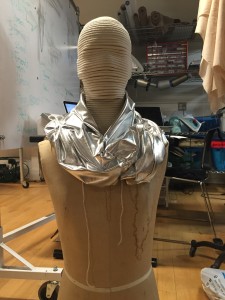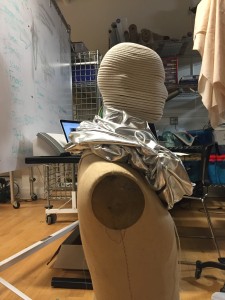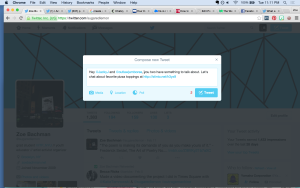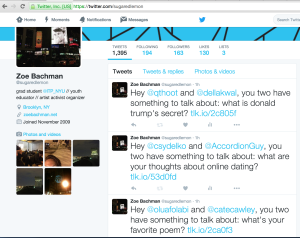Wearables, Wk 7: Construction, Cont.
Continuing exploring construction.
I bought a couple of paper lanterns and used their design as inspiration.

I took some of the 20 gauge wire and taped it in a spiral to the muslin mockup.
The effect was more hoop skirt than I like, so I’m trying to figure out a different kind of design that maybe incorporates wires just in the front and back, while leaving the sides hanging.
I also started sewing together the hood based on the tear-down. Putting it back together has proved trickier than I imagined….Even though I took notes and pictures through out the tear down I’m having a difficult time imagining the steps in reverse.
I started by writing down copious notes on the fabric, noting the orientation, seams and folds. This was helpful when sewing because I could easily follow the lines.
I put together inner and outer shells. Now the trick is to figure out how those pieces are sewn together and which seams are still unique. I’m still not entirely sure what order I should proceed in, but I’m going to go with one option and see what happens.
Wearables, Wk 6: Construction Experimentation
This past week I bought some muslin and cords and tried my hand at the shirring technique. Shirring creates channels in the fabric to create puffs – think of poofy disney ball gowns.
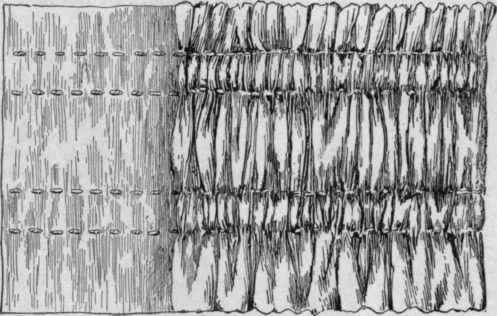
I went to Pacific Trimming in the garment district and was pretty overwhelmed by the amount of different cord options. Found something that had a bit of ply, but wasn’t overly stretchy. I laid out the cords on some muslin, but realized I should try out a smaller version first (still getting used to my production/materials experiment workflow).
Even just sewing this small prototype taught me a lot – in order for the materials to stay in place it’s key to have small channels that snuggly hold the cord, but not too snug that the fabric won’t cinch. Next step will be to add a second layer of muslin to create channels in my to-scale prototype.
I also spent some time breaking down a detachable hood on a jacket that I had from last semester. It’s incredible the amount of detail and design choices that go into something as seemingly simple like a hood. The hood is actually made up of six separate pieces of fabric, three shapes with inner and outer layers.
The stitching of the seams was more intricate than I would have expected, which makes me slightly nervous about replicating it now that I’ve totally taken it apart.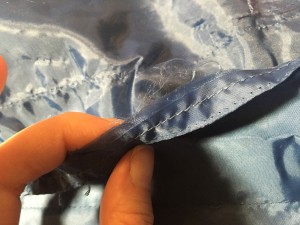
So after I pulled it apart, I used the pieces as patterns and cut out pieces of muslin. The next step will be to try and sew the muslin together.
MATERIALS UPDATE:
I’ve been expanding my hunt for more highly reflective materials for the outside and discovered that polyester/mylar sheeting is very reflective and used for emergency blankets as well as indoor horticulturalist pursuits…
I went on a field trip to REI to look at tents (curious about how compact shelter construction could better inform my design) and picked up an emergency blanket. It’s definitely highly reflective, though the creases make it more of an image refraction than pure reflection. I have some mylar sheeting in my amazon cart, but I’m going to hold off to see how well this works since the sheeting might be too thick anyways…

I also picked up some paper lanterns and will start working on a muslin prototype who’s design uses a wire armature.
Also did some research on sound and light proofing fabrics:

Purchased black out curtains (that are actually white?) that came highly recommended for their ability to block out both light AND sound. Should arrive within a couple of days. I’m thinking that I’ll use this fabric just in the hood area and then leave the black microfleece for the body.
Social Hacking, Assignment 3

What is considered the “norm” on the internet?
What does it meant that most sites are in cool colors with san serif fonts?
How can we change it? subvert it?
What if a different set of aesthetic norms were used instead?
I started on this project because I’m bothered by tech bro culture that is prevalent in many spaces I encounter, both online and in IRL – even at ITP. I’m weirded out specifically by presentations, like TED talks and product launches: these highly efficient, corporate, sleek-ness.
Recently I saw something that opposed emotion to intellect – why should these things be in dialectic opposition? Can’t someone or something both convey emotion and intelligence?
I started thinking about how emotion is performed online, both through content and aesthetics. Tumblr is a social media/microblogging site known for confessional content. It also happens to have a it’s own “aesthetic”:
I wondered what it would be like if I could experience the internet filtered through a lens crafted by this subculture, one that self-identifies as femme, queer and sees emotion as power, not weakness.

Radical Softness, Lora Mathis http://www.lokidesign.net/journal/2016/2/22/the-propaganda-of-pantone-colour-and-subcultural-sublimation
This project also relates to my interest in how our experience of the internet has changed, from the anonymous to the legalized. In comparison to other social media sites, tumblr is a hold out that allows users to put forth content behind a pseudonym.
From this article on tumblr:
Wong explained that teens perform joy on Instagram but confess sadness on Tumblr.
The site, he said, is a “safe haven from their local friends. … On Tumblr they tell their most personal stories. They share things that they normally wouldn’t share with their local friends because of the fear of judgment. That has held true for every person that I’ve met.”
And the culture of tumblr reflects that: people are valued based on their posts rather than their position IRL. I think it carries over the democratic feelings and structures of early internet, in many ways a nostalgia that’s expressed through it’s visuals. How does it carry traditions of the internet existing for those marginalized in traditional societies? What does it mean to exist in this kind of space?
I read this incredible article on how Pantone co-opted the tumblr aesthetic subculture for their latest “Color(s) of the Year” that inspired a lot of my thinking about this project. Highly recommend in terms of thinking about design and power.
“Radical softness is the idea that unapologetically sharing your emotions is a political move and a way to combat the societal idea that feelings are a sign of weakness.“
– Lora Mathis, interviewed by Hooligan Magazine
So, where to start?
I recently read this article (yeah, I read a lot) about how people in India see Facebook as a form neo-colonialism. What interested me the most, and was in another article that’s been going aroudn the web, is that facebook is positioning itself as the framework for the internet, or at least a gateway. Facebook wants to be the way most people experience the internet – a far cry from early internet evangelists who saw websites as a way for companies to have equal footing, challenging IRL dynamics.
What does it mean that Facebook’s blue/grey design is the norm? How does this shape the way people think of and experience the internet?
So, this week I attempted to make a google chrome extension that would take the tumblr aesthetic as an intervention into Facebook’s UX.
CODING:
We briefly talked about the Girls vs Git project in class, so being very unfamiliar with how to put together an extension I looked through the documentation and uploaded the extension to my browser so I could get an idea of how it looked and worked. I was…pretty confused, so I set that aside and went to play around in the Facebook console.
Boy, that code is complicated. I dug through a bunch of divs and found the very specific CSS selectors that allowed me to make changes. Apparently simply doing body{background-color: #e6ccff} wasn’t a possibility. I took notes on the various tags and then started thinking about an overall aesthetic that matched my research on tumblr aesthetics.
I showed it to Denny and he was like, this reminds me of Orkut – the social media site we had in india and Asia before Facebook came and took everything over:

http://en.blog.orkut.com/2010/05/more-updates-on-orkut.html
Which, obviously I found fascinating since I was just reading about Facebook’s India take-over.
I shared the screencap on Facebook and got good feedback, even acknowledgement that people have strong feelings about “Facebook Blue”
At this point I dove back into the code, carefully reading through the GirlsvsGit documentation, Chrome Extension Documentation…I even got my hand on the syllabus for “Hacking the Browser” and found some helpful tutorials there.
One big take-away is that I started learning JQuery, which is something I’ve been meaning to do. The biggest challenge was finding right CSS elements to change and even being unsure if my JQuery syntax was correct, since it was so new to me.
I played around a lot with the aesthetics, going into Photoshop to get the exact colors and build an appropriate palette:
I was able to upload the files to the developer console (title: FaceTumblr) but…nothing happens when I go on Facebook. So. Fail.
I kept playing with the code: changing syntax, commenting stuff out, trying different CSS selectors. Alas, still not working. Probably time to bring in the big-guns aka meet for office hours with a person who knows how to do this.
In any case, here are some screenshots from when I was trying out different things in the console that theoretically could be the extension:
*Also, I need to learn Git so I can actually post my code….
Wearables, Wk 5: First Prototype
Went to mood, got fabric swatches of black fleece, reflective and this lilac mesh I liked. Then I went to PS fabric and got some muslin, silver lamé and black microfleece to experiment with.
Started by playing around with different draping techniques, creating hoods and veils using the muslin.
I moved on to the silver lamé, which was fun to work with and helped me to better visualize a final concept while working through design problems. Played with different ways of creating a hood, openings in the garment, how it’s fitted and how it expands and contracts.
Thinking about overall structure, want to try out three variations:
1. Shirring – using a cord to pull fabric up and down
2. Armature – creating a flexible understructure, similar to a paper lantern that can condense and expand
3. Accordion – a fabric that is folded in a specific way that allows for expansion but has enough memory that it can return to its original shape
Next steps:
- build another hood prototype, but with a pattern
- try out armature structure
- experiment with shirring using muslin
RWET, Assignment 2: Storm Warnings
CONCEPT:
I was excited to get to the point of learning mashups – goes back to Hartford’s point about juxtapositions being at the heart of poetry.
When I was going through the mashup exercises, I was reminded of this time senior year when my friends pulled a super nerdy prank on me. We were in AP English together and they asked me to help analyze this Adrienne Rich poem. Except, it wasn’t really an Adrienne Rich poem – they’d taken her poem Storm Warnings and simply switched out some of the words and altered the syntax (like I said, super nerdy prank). I figured it out, because I loved that particular poem and immediately realized the similarities.
Thinking about that incident and the intense storm we had the other night gave me the idea to do a mash up of Rich’s storm warnings and the National Weather Service’s storm warning from yesterday. I’ve always had a weird fascination with the language they use when writing storm warnings – in some ways it’s the typical dry language you’d expect from a government agency, but there’s also a sense of care and occasionally the flare of the dramatic. If you ever want to look up past storm warnings, there’s a great site that archives them: https://mesonet.agron.iastate.edu/request/gis/watchwarn.phtml as well as one from NOAA: http://www.spc.noaa.gov/products/watch/ww0030.html

http://www.accuweather.com/en/weather-news/live-severe-storms-tornadoes-louisiana-mississippi-alabama-florida-georgia/55604043
Here are the two source texts:
http://www.atmos.umd.edu/~dankd/adrienne.html
Storm Warnings
The glass has been falling all the afternoon,
And knowing better than the instrument
What winds are walking overhead, what zone
Of grey unrest is moving across the land,
I leave the book upon a pillowed chair
And walk from window to closed window, watching
Boughs strain against the sky
And think again, as often when the air
Moves inward toward a silent core of waiting,
How with a single purpose time has traveled
By secret currents of the undiscerned
Into this polar realm. Weather abroad
And weather in the heart alike come on
Regardless of prediction.
Between foreseeing and averting change
Lies all the mastery of elements
Which clocks and weatherglasses cannot alter.
Time in the hand is not control of time,
Nor shattered fragments of an instrument
A proof against the wind; the wind will rise,
We can only close the shutters.
I draw the curtains as the sky goes black
And set a match to candles sheathed in glass
Against the keyhole draught, the insistent whine
Of weather through the unsealed aperture.
This is our sole defense against the season;
These are the things we have learned to do
Who live in troubled regions.
-Adrienne Rich
http://www.spc.noaa.gov/products/watch/ww0030.html
URGENT – IMMEDIATE BROADCAST REQUESTED
SEVERE THUNDERSTORM WATCH NUMBER 30
NWS STORM PREDICTION CENTER NORMAN OK
740 PM EST WED FEB 24 2016
THE NWS STORM PREDICTION CENTER HAS ISSUED A
* SEVERE THUNDERSTORM WATCH FOR PORTIONS OF
SOUTHERN CONNECTICUT
NORTHEASTERN NEW JERSEY
SOUTHERN NEW YORK
COASTAL WATERS
* EFFECTIVE THIS WEDNESDAY NIGHT AND THURSDAY MORNING FROM 740 PM
UNTIL 200 AM EST.
* PRIMARY THREATS INCLUDE…
SCATTERED DAMAGING WINDS LIKELY WITH ISOLATED SIGNIFICANT GUSTS
TO 75 MPH POSSIBLE
A TORNADO OR TWO POSSIBLE
SUMMARY…A LINE OF THUNDERSTORMS…SOME OF WHICH COULD CONTAIN
DAMAGING SURFACE WINDS AND POSSIBLY A TORNADO…WILL MOVE FROM WEST
TO EAST ACROSS NORTHERN NEW JERSEY…THE NYC AREA…AND PARTS OF
CONNECTICUT LATER TONIGHT.
THE SEVERE THUNDERSTORM WATCH AREA IS APPROXIMATELY ALONG AND 90
STATUTE MILES EAST AND WEST OF A LINE FROM 10 MILES EAST OF
POUGHKEEPSIE NEW YORK TO 35 MILES SOUTH OF ISLIP NEW YORK. FOR A
COMPLETE DEPICTION OF THE WATCH SEE THE ASSOCIATED WATCH OUTLINE
UPDATE (WOUS64 KWNS WOU0).
PRECAUTIONARY/PREPAREDNESS ACTIONS…
REMEMBER…A SEVERE THUNDERSTORM WATCH MEANS CONDITIONS ARE
FAVORABLE FOR SEVERE THUNDERSTORMS IN AND CLOSE TO THE WATCH
AREA. PERSONS IN THESE AREAS SHOULD BE ON THE LOOKOUT FOR
THREATENING WEATHER CONDITIONS AND LISTEN FOR LATER STATEMENTS
AND POSSIBLE WARNINGS. SEVERE THUNDERSTORMS CAN AND OCCASIONALLY
DO PRODUCE TORNADOES.
&&
OTHER WATCH INFORMATION…CONTINUE…WW 27…WW 28…WW 29…
AVIATION…A FEW SEVERE THUNDERSTORMS WITH HAIL SURFACE AND ALOFT
TO 1 INCH. EXTREME TURBULENCE AND SURFACE WIND GUSTS TO 65 KNOTS.
A FEW CUMULONIMBI WITH MAXIMUM TOPS TO 400. MEAN STORM MOTION
VECTOR 21050.
CODE:
After doing the mashup exercises, I decided to try out the glitch, mashup and replacer code – altering them so they used argv instead of hardcoding the texts.
glitch_argy.py code
Playing around with the glitch_argv.py code, altering the number of characters and lines:
rrents of the undiRM PREDICT
like come on
RRSEY…THE N
raveled
By secretPORTIONS OF
change
Lies A TORN
utters.
WS STORM PREDICTION
elements
WhiN CENTER HA
unrest is mTHUNDERSTOR
ned
Into thD SIGNIFICAN
secret curSEY
SOUT
when the air
MNDS LIKELY WITH
There’s a lot in here that’s interesting…”By secretPortions OF /change lies A TORN / utters” might be my favorite.
While playing around, I thought about whether or not I liked the disjuncture of the all capitals – I decided that I liked is a visual and decided to preserve the style.
Some more fiddling with length of characters and the number of lines produced:
This is our sole defense EASTERN NEW JERSEY
the wind will rise,
DO PRODUCE TORNADOES.
Next I tried the mashup code, switching it to argv
THE NWS
SEVERE WATCH instrument OK and CONDITIONS
alike LOOKOUT the DAMAGING season;
LATER AND EST time, black By glass
LISTEN Time CENTER
OR
1 TO Nor
this an against Time do
NUMBER SHOULD
AREA…AND black time, TO MOVE averting
POSSIBLY land, is And INCLUDE…
27…WW our NEW prediction.
glass WEDNESDAY THE OF FEW defense been
and LATER APPROXIMATELY 400. AND
set
I had some difficulty changing the replacer.py to argv. This was the code I wrote:
But it only put out one word on each line.
So I hardcoded the texts into a copy of replacer.py:
Here’s one:
The glass SEVERE been falling all the afternoon,
THE knowing better than the instrument
What winds are walking overhead, what IS
Of grey TO is moving across the land,
I leave the book AND a pillowed chair
And THUNDERSTORM from window to closed window, watching
LATER strain against the sky
And think again, as often when the THE
Moves inward SEVERE a silent core of waiting,
How WEST a single purpose time has traveled
By secret currents of CONDITIONS undiscerned
Into this MILES realm. Weather abroad
And weaYORK.r in YORK. heart alike come on
Regardless AND prediction.
Between foreseeing DO averting change
30 all the mastery of elements
Which clocks MILES weatherglasses cannot alter.
Time in the hand is YORK control of time,
PRECAUTIONARY/PREPAREDNESS shattered fragments of an instrument
A proof CONTAIN the wind; the wind will rise,
We can only close the MAXIMUM
I draw the curtains as the JERSEY goes black
And set a match to candles sheathed in SEVERE
Against the keyhole draught, the insistent 27…WW
Of weather through the unsealed BROADCAST
This is our sole LINE against the season;
FOR are the things we have learned to do
Who live in OF regions.
This doesn’t have as much variation as the first two, of which I think I prefer the first the best.
*Another application I want to test is to take tweets from Trump and Bernie supporters – or sentences from Trump and Bernie speeches – and have them go every other line, so it appeared like a dialogue. Always intrigued by the findings that social media, twitter in particular creates silo’d communities that continue to grow insular. It’s even apparent in the way users self-identify – “if you don’t like what I say, don’t follow” “no liberals wanted”, etc. I’m not a big twitter user, but it’s common to see people I follow on facebook make comments like, “if you don’t like my politics then unfriend me” or “I’m unfriending any of my friends who believe X”. I don’t judge these people’s choices, but I wonder how helpful it is to cast out people who hold different views rather than engaging them in meaningful conversation to try and understand their perspective and vice versa. So, at some point I’d like to put these people in conversation who would probably not come across each other in the twittersphere.
Temp Expert, Wk 5: It’s great when the expert is your friend
I mentioned earlier that when I was assigned biodiversity that my mind immediately jumped to coral, and I credit this to the fact that my childhood friend (soon to be Dr. Sarah Gignoux-Wolfsohn) is studying White Band Disease for her dissertation. I got a chance to talk to Sarah last week and not only FINALLY learned how to pronouce xooanthellae (zoo-AN-thel-EE), but I learned a lot more about the dangers that coral reefs are facing but also the sense of hope and positivity that is present amongst most coral researchers.
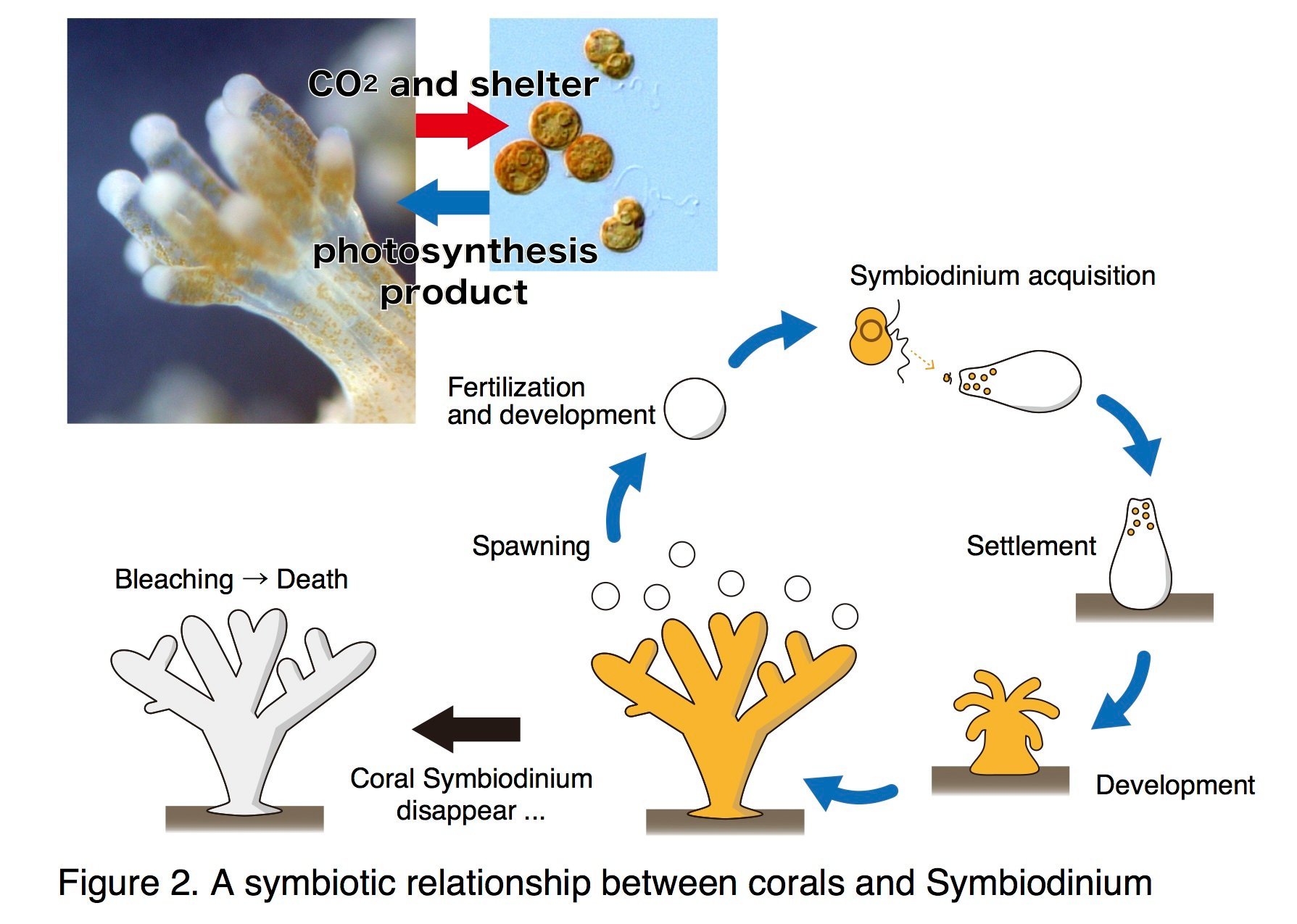
We talked on the phone for over two hours. Sarah provided insights onto the current state of coral disease research. When it comes to determining the causes of coral disease, it’s really tricky. It could be viral, or rising temperatures, or both or dependent on the breed of coral or cade (also a new term for me) of xooanthelle. They have found a cade of xooanthelle that are very heat tolerant (the ones I mentioned in the Indian Ocean in my last post) so that gives scientists hope that coral reefs aren’t simply dying – they’re actually adapting to change and becoming more resilient.
Coming from an anthropology background, I was curious about how the coral depletion affected the local communities in Panama, where Sarah is doing her research. Sarah says that the entire fishery economy has shifted to the Pacific coast, though a few individuals still practice stab fishing. It takes at least 5 hours to cross Panama – quite the trek. Reminded me of how Maryland now imports a lot of their crabs from Louisiana since the blue crab population has significantly decreased in recent years.
Another interesting fact was that scientists didn’t know that there was such a thing as coral disease until the 1970s – within the lifetime of many scientists still doing research today. Also, the Smithsonian has a research center in Panama but within the past year most of its upper administration has been fired from getting mining kickbacks (mining runoff is a known cause of water pollution).
When I told Sarah about the global relations angle I was looking at, we discussed how the advent of colonialism brought modern forms of production…but it also brought plastic. I experience this when I was in Senegal – know one knows what to do with trash and recycling (unless it’s glass bottles, then they’re quite efficient). Sarah says that most people in Panama dump their trash at the beach or purposely throw it into the water. In fact, the water near the shore is so bad that researches have to travel by boat for over an hour to get to a coral reef that they can study.
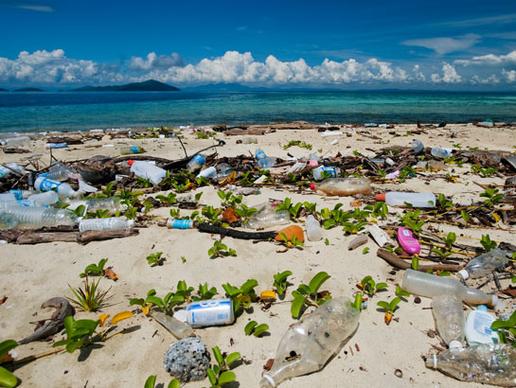
I mentioned to Sarah that I was interested in incorporating plastic into my project and she told me that she actually did a project for her department’s open house where they made a coral reef out of plastic she had saved! Turns out Sarah is really interested in using art to educate people about coral reefs. She also reminded me about the project where they crocheted a coral reef, and gave me the name for the woman who initiated that project so I could get in contact with her.

Leaving the conversation, I have to say how amazed I was that I knew most of what Sarah was talking about – just a testament to the loads of research I’ve looked at over the past couple of weeks. I was also feeling much more positive than I had been and that’s really what we got to at the end: how you can have people feel like they have their own role to play in creating positive change and not overwhelming them with facts, figures. Sarah says she tries to use as little plastic as possible and when people ask her what they can do to help, she suggests they do the same.
EDIT: just found this cool video about using sculptures to artificially construct new coral reefs!
Underwater Sculptures Are Helping Rebuild Our Ocean's Coral Reefs
Underwater artwork is helping rebuild our ocean's coral reefs.
Posted by The Huffington Post on Wednesday, February 17, 2016
Wearables, Wk 3: Deeper into Brainstorming and Concept Building
What do you want to happen to the human beings that use the objects you make?
1. What is the purpose of the artifact you are designing?
It’s purposes is to create a private experience for someone, even when within a public space; it is more about augmenting the person’s experience of physical space, though others might still perceive them (think sunglasses) and actively making those who try and enter that space feel uncomfortable and disoriented.
2. Why does it exist?
As humans increasingly live in urban centers, the lack of personal space and privacy is shrinking. Wanting to live a private life is stigmatized (not participating on facebook, worrying about surveillance, being anti-social). This object allows its wearer to escape the public eye, while still within it. It gives them a space to breathe and block out the world.
3. What will it DO? (How will it do it – but you can only answer this if you are clear about the rest of the answers)
It will “hide” its user from the outside world by providing a safe space into which to escape, while also actively alienating anyone who tries to interact with that person.
4. How does it work? Step-by-step – (you open a box, a drawer, you plug it in, you charge it, you press on a button to activate it or it is always on… etc)
Person puts object on in a similar fashion to a neck warmer. It can rest across their shoulders or around their neck.
When they want to escape, they pull the back part of the cowl neck up and over their head and the front part up and over their chin. They can use the drawstring to close the opening.
5. Why would someone want to use it? What do you add to their life? Remember that value is shared, applied based on some sort of value system onto objects. So think about communication, and shared values.
Privacy is a commodity in our increasingly urbanized lives. High cost of living means that most people can’t live, work or relax alone. We’re constantly assaulted by random people trying to interact with us, or surveillance cameras trying to peer at us. What if we could escape while still remaining seen?
There’s already a common practice of people hiding in plain sight – behind hands, sunglasses, scarves and hoodies. Hiding can be seen as a vulnerability or even suggesting a criminal intent (Trayvon Martin) – but what if claiming your privacy was instead framed as a radical act? As people, corporations and the government increasingly infiltrate our lives, moments of peace, quiet and solitude are often hard to find. We need to actively create our own spaces where we can block out the rest of the world – to dream, meditate, and get to know ourselves better…only to emerge as saner and better able to engage.
The piece uses soft, dark fabrics on the interior and highly reflective materials on the exterior. The point is to create a small haven that is not infiltrated by outside stimuli – any light or sound, people or cameras are reflected back. This is a sign to the outside world that you are to be left alone. Like a snail in its shell, you’ll come out when you’re ready.
6. Objects have “qualities” – what are the key qualities of the object you will create?
inside: soft, comfortable, dark
outside: metallic, reflective, harsh
flexible: must be able to expand and contract (thinking accordion folds)
7. List all the things you want to make, all the ideas you want to manifest. List them simply, as words, not sentences
-
a veil
a neck cowl with a light
a neck cowl that animates to cover the bottom half of face
a safe space suit (?)
something that allows you to cry in public without being seen
something that allows you to pee anywhere
something that allows you to hide in public
something that is a private space, a fort or hideaway but in public
8. What is the anchor (the key idea)? Can everything else connect and flow from there?
being in a private space while still being out in public – “hiding while in plain sight”
9. List all the forms your idea can take
a jacket that turns into a fort
a “safe space suit” that you can hide away from the world in
a giant cowl neck that envelops your head
a hat with a veil that has fiber-optics and reflective fibers woven/laces together into a webbing
10. What resources (skills, friends with skills, time, access to equipment etc) do you have to make our project happen?
access to equipment (soft lab)
fellow ITP students to user test on
Fletcher – works at a space suit company…might have thoughts?
Wearables, Wk 3: Objects and Their Lives Assignment
What is your anchor?
Hiding in Plain Sight
Describe in 1 paragraph your project. [note: I realize this is not one paragraph. sry.]
– what are its key qualities
– what does it do? who is it for?
– how does it work?
– what are its REQUIREMENTS?
– what is the INPUT / OUTPUT (see questions above)
The object’s key qualities are that it protects the user by providing a comfortable inner space that blocks light and sound, while the outside is a reflective surface that bounces back sound, light and any people who try to interact with you.
This object protects the user from outside stimuli, creating a safe, private space within which to exist – even in the most public of spaces. This is for the user who craves their own private bubble or the ability to hide from the world while out in the world. This may be the younger person who shares a bedroom, the employee in an open-plan office, a person who has hyper-sensitivity to outside stimuli, the teen who does not want to be harassed.
The piece is worn around the neck, similar to a cowl. It’s accordion folds allow the object to expand and contract. If the user wants to enter their space, they simply pull the fabric up and over their head and up and chin and pulled further down the torso. The wearer can use a drawstring to further enclose themselves. Soft, dark inner fabric and noise-canceling construction makes the user feel like they are apart from the world, while anyone who tries to interact with them will find themselves only confronted with their own image, light in their eyes and their words bounced back at them.
The REQUIREMENTS of the project are:
- that the interior is a dark, comfortable space that blocks out light and sound
that the exterior is mirror-like, highly reflective
that the construction/fabric can expand and contract in shape
The INPUT/OUTPUT:
At the moment, the input is the user’s emotional well-being and sense of comfort – as soon as they start to feel uncomfortable in public [could this be measured by heart rate? or some other bio sensor?] or want to hide, they pull [or does it animate on its own?] the piece up over and around them to block out any sound or light. Not recommended while in motion.
Note: I also updated my moodboard to better reflect my current idea and research.
I also wrote another post that further explores the concept and my thinking around how privacy is a commodity and a radical act: http://www.zoebachman.net/itp/?p=568
Social Hacking, Assignment 2
When I first started spending time on the internet as an adolescent, I was intrigued by the possibilities of interacting in chat rooms filled with anonymous strangers or going on sites like NeoPets. The internet allowed me to meet people from all over and explore the world in a new way. Now any time I get a friend request on facebook from someone I don’t know, I delete it.
There have been plenty of think pieces about how the internet has changed. One of my favorite articles is by Hossein Derakhshan, an Iranian blogger I came across during my undergraduate research. In his piece, he discusses how the internet has shifted from being decentralized and expansive to the stream, akin to a TV.
We’re increasingly siloing ourselves online. Rather than approach the internet as a space to be explored, we pick and choose and consume what we think (or the algorithms tell us) is best. To quote Derakhshan, “The web was not envisioned as a form of television when it was invented. But, like it or not, it is rapidly resembling TV: linear, passive, programmed and inward-looking.” Most often, feeds are full of people who share the same ideas, life-experiences and values. Its very common to see people post that they will unfriend those who share dissenting thoughts.
In not getting exposure to alternate experiences and modes of thought, do we risk increasing the differences amongst us, possible leading to greater conflict IRL?
Participating in diverse environments is hella important. Science backs it up! Because all this made me think…if we know diversity is better for us, why don’t we build that into our online experiences?
I was talking to a friend about this and he said something that resonated, “Humans want to be around people who make us feel better.”
And I thought, sure, I can agree with that. I tend to feel more comfortable around people I know and who have had similar life experiences…but, I also know that if I hadn’t reached beyond those small communities, I would have never formed very important relationships, or collaborated on awesome projects, or simply learned new things. It’s important for us as humans to challenge our self-made and imposed socio-cultural boundaries. How can we actively engage possibly in an uncomfortable but ultimately beneficial way online?
————————————–
What would it mean to intentionally bring people who might not otherwise “meet” online into the same space? What if these people were not only different, but held completely opposite views?
Been thinking a lot about subjectivity and Lacan’s mirror theory: that we constitute subjectivity in relation to an other – we know what we are because of what we are not.
I wanted to construct an experience that brings together people on social media platforms who might not come across each other or choose to interact. To create a moment and space that breaks down divisions and see what possibilities emerge when two people are randomly thrown together.
How does one break out of conscripted online social experiences? Chat rooms were the place to be anonymous and meet anyone from around the world, so could this kind of online space be brought back in intentional way?
[I’m still figuring out some tech stuff, but Kyle made the point that before one creates an automated experience, there’s a lot of manual work to be done. So this project is an early iteration and experiment of a future automated process.]I wrote tweets from my personal account that mentioned two random people on twitter and invite them to chat on a specific topic.
After messing around at first, I came up with a few different variations:
Experiment A: mentioning both users in tweets, inviting to join chat in tweet
Experiment Av1:
Two random people
Random subject
Experiment Av2:
Two people from same search query
Random subject
Experiment Av3:
Two people from same search query
Subject related to search query
I made a spreadsheet to keep track of the interactions and chat rooms, which you can look at here: https://docs.google.com/spreadsheets/d/1aGoiU4rTUmmeO-Icfx0cIp9issAFQLRufns7sSaVilA/edit?usp=sharing
It was more challenging than I expected to find “random” people to use. Twitter kept wanting to feed me big name brands and celebrity users. Even when searching for a random topic there was a hierarchy of tweets with brands and celebrities first, then those who I follow or who my friends follow.
Once I found my two people, I’d come up with a random topic for them to talk about. I’d tweet, “Hey @… and @…, I think you two would have something to talk about. Let’s chat about [topic] at this [url]”
Then I’d create a chat using the tlk.io free chat app, post the topic at the top and wait.
I brainstormed a list of random topics, bouncing from the banal to the inflammatory, the absurd and sincere.
TOPICS:
your favorite pizza toppings
your feelings about Beyoncé’s new music video
this picture of a sloth
Bernie Sander’s viability as a candidate
your childhood neighborhood
first computer game
universal health care
student loan debt
the prison industrial complex
what was the coolest cloud shape that you ever saw
what your first screen name was
current favorite song
what city you want to visit the most in the world and why
what you love most about where you’re from
best sandwich
online dating
I wrote 15 tweets, but so far no bites. I guess I’m not totally surprised, though really wishing that someone will be curious and see what this is all about.
————————————-
FROM HERE
– What can be changed about this experience so that people will actively engage?
– How can this be automated? Would it have the same effect if it was?
– What could this look like on a larger scale, involving more than two people?
– Is it possible to recreate “chance” encounters online? How much control over our social lives is good?
Edit: recently found out about the practice of “uncomfortable design” that I think would figure well into this discussion. Nicholas Hubbard posted this article in the NYU ITP facebook group. A quote that I thought spoke to this project was:
Our last form of discomfort concerns intimacy. Computers are increasingly mediating our social experiences which gives rise to the possibility of distorting normal social relations in uncomfortable ways, for example isolating people (used in both Breathless and Ulrike and Eamon Compliant), employing surveillance and voyeurism (also used in both), and establishing unusual intimacy with strangers.
Oh, also just found this Pew Research Center Report on different types of networks that exist on twitter, from the polarized (what this project is interested in) to tight crowds and brand clusters. The report says that while two groups of people can talking about the same subject, their language, links and conversation can be completely opposite.
Temp Expert, Wk 4
This week I decided to delve deeper into my research on coral reefs. Now, normally I wouldn’t advocate Wikipedia for serious research but I find that Wikipedia is great for exploratory practices. So, I opened the article on coral reefs and let the internet black hole lead me from there.

1. Coral diseases
I started finding that there were a couple of topics related to coral reefs that really grab me. The biggest are the diseases that are killing off coral in large amounts and when I say large I mean LARGE, like 90% of the coral in the caribbean has been decimated. I found out that my friend actually does research on white band disease, a virus-based infection that is highly prevalent in the caribbean. In fact, a paper she co-authored is cited in the wikipedia article on WBD. There still unsure exactly the causes of WBD, but they believe that rising ocean temperatures contribute to the spreading of the disease and that those rising temperatures are directly related to human activity.
Coral bleaching is fascinating since it occurs when the coral is under duress and expels the zooxanthellae that live in the coral. The coral turns white because coral doesn’t naturally have color – they get it from their symbiotic relationship with these organisms who undergo photosynthesis. When the zooxanthellae leave, the coral loses its color as well as 90% of their nutrients. There are a couple of different reasons why scientists believe coral bleaching is happening, one recent study finds its source in a viral infection.

2. Sunscreen = coral killer
Another interesting fact is that sunscreen has been shown to have a toxic effect on coral colonies. I found this absolutely fascinating, because I’ve just never imagined the possibility of wearing sunscreen having a negative consequence. Of course, this is directly related to ecotourism efforts, so it becomes one of those situations that we talked about in class last week – making positive environmental changes might adversely affect things that are good for our economy, in this case the tourism industry and its role as the main source of income for many of these tropical regions.
3. The coral trade/tourism
An image that came to mind as I begin my research was of a wealthy, white woman wearing coral jewelry. Reminded me of people in the Philadelphia main line suburbs, where I went to high school. I was curious if coral trading was a practiced but frowned-upon activity. Turns out that most decorative coral is actually fake, and that yes, it is frowned-upon to trade in coral. Most aquarium dealers don’t touch the stuff (and apparently it’s notoriously difficult to clean). Came across this fantastic article about the coral trade, its criminal potential. Coral is sold as interior decorations, jewelry and souvenir items. What’s interesting in that most coral used for souvenir purposes doesn’t even come from the region where it’s sold.

I think what resonated most was that the people in the Solomon Islands killing the coral to sell were doing this because they were so impoverished. This got me interested in thinking about the post-colonial implications and relationship to coral degradation, as well as the relationship between tourism and coral death. In some countries, coral reef related tourism makes up for 80% of their economy.
4. Recovery/Resilience
The last direction that I was looking into was coral’s ability to adapt and survive some of the stressors that often put it at risk. Coral bleaching can be reversed and WBD can be cured. It was also found that coral in the Indian Ocean has actually adapted to warmer temperatures and murkier waters, leading some to hope that coral will not decline as rapidly as some would believe – because the numbers are absolutely terrifying, with many varieties considered on the brink of extinction and all will be under threat by 2050. Ken Nedimyer in Florida is often cited as someone who is working tirelessly to save coral by creating coral farms. It’s interesting because rather than frame it as an ecological initiative, Nedimyer recognizes the profit capabilities of coral and the huge economic losses that will occur if coral is wiped out.
I was also curious about artificial reefs, but didn’t get as far with that research. I like the idea of using trash/recycled materials to provide new homes for coral – possibly a win-win. However, there is some research that According to The Ocean Conservancy, a Washington-based environmental group, the benefits of artificial reefs need to be re-examined. Jack Sobel, a senior scientist at the group, has said “There’s little evidence that artificial reefs have a net benefit,” citing concerns such as toxicity, damage to ecosystems and concentrating fish into one place (worsening overfishing).

BRINGING IT TOGETHER
At this point, I’ve started to see some themes and connections emerge across my research. I’m very interested in this motif of whiteness that keeps creeping up – from bleaching to WBD, to sunscreen used to protect skin (and make sure it stays white), to the implications of colonialism in devastating tropical economies.
Right now, one thought is to do an installation of all white objects (including dead or fake coral). I’m thinking about using this collection of objects as a canvas for a mapped projection, so I can work with different kinds of footage as well as play with color, animating color to mimic coral bleaching.
Multi-Object Projection Mapping Example from Luma on Vimeo.
I want the imagery to speak to not only the environmental implications of the disappearance of coral reefs, but the human impact. I think it’s still hard for people to realize the importance of coral reefs to human sustainability world wide. And that might have to do with the fact that it is a problem that affects primarily impoverished, formerly colonized and very much marginalized communities. They are the ones who will lose a source of income, food, as well as protection from erosion and storms. Coral reefs don’t exist in this quantity or have as much importance in the Global North (though this also depends on how we think about Australia in this context). Thus US has made some strides and has given money to actively look for solutions to coral disease as well as coral restoration.
Another interesting point I came across is that people are generally not as phased by coral death as they are with other, “cuter” animals. Dead coral doesn’t have the same kind of imagery as dead dolphins. So how do we change this perception and make people care more about this situation? How do we make people feel empathy for coral?
EDIT: Here’s a great, fast rundown on why coral depletion is not simply a marine conservancy effort, but one that affects humankind as well
EXPERTS
I’m contacted my friend who is pursuing PhD research in marine biology at Northeastern and recently wrote a paper on the causes of WBD.
I’m going to contact Kate Lunz, the scientist who was interviewed for the article on the coral trade. I had a hard time finding her contact info, but LinkedIn tells me that my friend is a mutual contact so I asked her if she would provide me with her email.
I’m also looking into contacting an anthropologist who studies the impact of coral reef disappearance on tropical communities.
